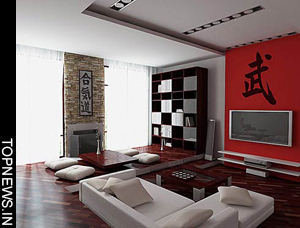How to create living space in all rooms of a home
 Hamburg - There was a time when a sofa could have a pressed board on the back because it would never be placed anywhere except against a wall.
Hamburg - There was a time when a sofa could have a pressed board on the back because it would never be placed anywhere except against a wall.
Trend experts say those days are over as individual rooms are blending into one another to create large living spaces that are divided only by a shelf or sofa. And this development is having an affect on other furniture as well.
"All furniture fits everywhere," is how the association for the German furniture industry describes the new trend in words.
The popularity of lofts is what triggered the new flexibility. But in fact only a small number of people actually live in old factories or warehouses converted into apartments or work in offices without space-dividing cubicles. Nevertheless, many furniture makers prefer to set up their designs to fit this type of ambience.
Average consumers would love to emulate this look, but in reality it's hard to achieve the desired look because space is rare and expensive, organizers of a recent furniture trade fair in Cologne said. In ordinary apartments and houses, the space must be restructured to give the impression of openness. Put bluntly, dead corners and areas that are seldom used, are obsolete.
"We want to have a real life in all rooms," said interior decorator Katharina Semling of Oldenburg, Germany. If there's not already a loft, then the walls between the kitchen and dining room or between the dining room and living room should come down to create an open living space. Furnishing have to fit in accordingly.
Kitchen islands can help expand countertops and if the island includes a stove top, more people can help stir the stew. Equally trendy in the kitchen are benches, but these have nothing to do with the old corner bench ensemble.
"They are very fine pieces of furniture made of solid wood, for example, and covered in leather. The Foster 510, a minimalist bench from Walter Knoll of Herrenberg, Germany is an example. It combines fine leather and a filigree steel base. Another example is the Quant from Cor of Rheda-Wiedenbrueck, Germany. It features woods from nut trees, cherry trees and oak and thick pillow tops in a retro look.
Among dining room tables, function is important. The designs of Team 7 in Austria are typical. Dark woods, pure lines and large formats are its calling cards. Nearly all furniture makers have a table for a small room that can be enlarged by folding, swivelling or pulling an extension out.
When walls are taken out, there's less space for items that fit along a wall. Thus, the new furniture also has to look nice from behind.
"Sofas that until now have been placed against a wall today are open and free in the room. And it can easily be turned and thus useful in every direction," the furniture maker association said.
To give the rooms structure, niches are necessary. The Israeli-French designer Arik Levy considers this the biggest challenge for furniture designers.
"The new, open architecture creates the necessity for the design of a new type of room divider," he said. SH05 Arie is the name of his solution to this problem. Levy designed it for e15 of Oberursel, Germany. Behind a sober combination of numerals and letters, there is a shelf without a back and without side walls, making it accessible from all sides.
In addition it can be extended without limit - putting many elements together and the shelf practically organizes a wall for the room. And this is important in the era of loft architecture, said Levy. The space within apartments has indeed changed, but people with their need for a place to withdraw have not. (dpa)